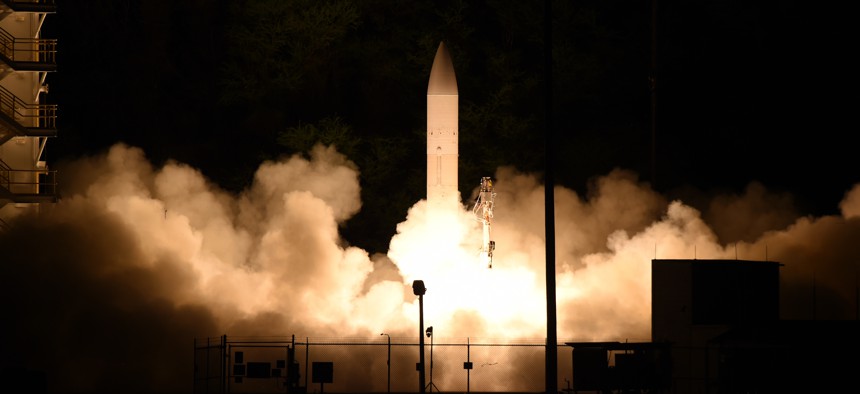
A common hypersonic glide body launches from Pacific Missile Range Facility, Kauai, Hawaii in a March 2020 flight test. U.S. Navy
Better Weapons or More Soldiers? Army Chief Says He's Being Forced to Choose
“We'd like to make it bigger, but what we have to do is prioritize,” said Gen. James McConville.
The U.S. Army’s top general said the budget he’s been given is forcing him to choose better weapons and smaller, less-expensive training over something he also wants: more soldiers.
Army Chief of Staff Gen. James McConville said he would prefer to increase the size of the force, but he needs to fund new and improved weapon programs and make sure soldiers are properly trained and ready to deploy.
“We really don't want to make it any smaller,” McConville said Tuesday during a Association of the U.S. Army virtual event. “We'd like to make it bigger, but what we have to do is prioritize.”
Congress has authorized just shy of 486,000 active-duty Army troops. When the National Guard and Reserve troops are factored in, the Army has just north of 1 million soldiers.
The Army is roughly the size it was at the time of the 9/11 attacks, McConville said. The United States added nearly 100,000 soldiers between 2007 and 2012 to meet at the peaks of the wars in Iraq and Afghanistan. In 2019, then-Army Secretary Ryan McCarthy called for an increase to 500,000 active-duty soldiers.
President Joe Biden, who has yet to nominate any service secretaries, is expected to request between $704 billion and $708 billion for the Pentagon when the administration sends its fiscal 2022 budget request to Congress in the coming weeks, according to Bloomberg. That’s roughly what lawmakers appropriated for the Defense Department in fiscal 2021.
McConville’s desire for additional troops is as old as the military. But when faced with budget limits, military leaders typically target three areas: force size (end strength and structure), readiness (training and weapons maintenance) and modernization (buying weapons and developing news ones).
“I don't see us growing at the rate I would like to grow the end strength,” he said. “I believe that we must modernize.”
Among those projects are hypersonic missiles that Army leaders say are needed for deterrence and if the U.S. were to go to war with China.
“Long-range precision fires will give us the capability to penetrate anti-access area-denial environments, to suppress air defenses from strategic range and set up our own anti-access area-denial capabilities,” McConville said. “We will field hypersonic mid-range and precision- strike missiles some time in the fiscal year 2023.”
In addition to freezing troop growth, McConville is looking to save money by training soldiers in smaller units.
“You get more readiness out of doing small-level training and then use your combat training centers to get the higher level training,” he said. “We might be able to be more efficient with the money that we spend on readiness.”




